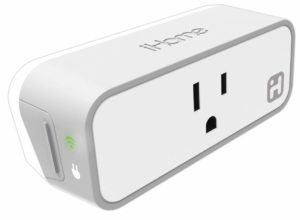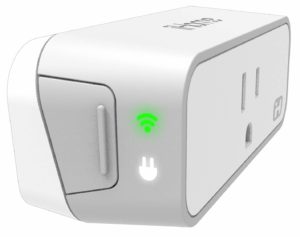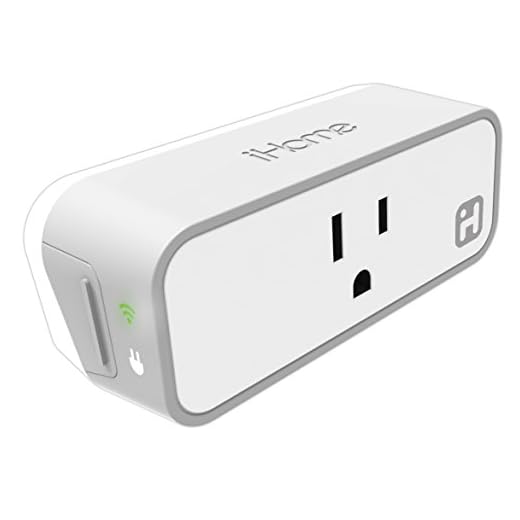The iHome name should ring familiar to Apple aficionados. Their lineup of speakers and alarm clocks designed for the iPhone put the company on the map. But in recent years, they’ve branched out into the lucrative smart home market.
At $30, the iHome ISP6X is priced a bit on the higher end. And looking through the features, it’s easy to see why. The iHome Smart Plug boasts the most prolific list of 3rd party platform support out of any smart plug on the market. They cover the common ones like Amazon Alexa and Google Assistant. But where they really separate themselves is being one of the few plugs that works with Apple HomeKit.
Great Design and HomeKit Setup a Breeze
 At 1.5 by 2.8 inches, the ISP6X is on the smaller end of smart plugs. It’s tiny footprint prevents blocking of the adjacent outlet and allows for two iHome’s to be used at the same time. It can handle up to 1800 watts which is more than enough for most space heaters and portable air conditioner units.
At 1.5 by 2.8 inches, the ISP6X is on the smaller end of smart plugs. It’s tiny footprint prevents blocking of the adjacent outlet and allows for two iHome’s to be used at the same time. It can handle up to 1800 watts which is more than enough for most space heaters and portable air conditioner units.
From an aesthetic standpoint, it has a modern look of a grey border around a white plastic interior. The manual on/off button resides on the left side next to two indicator lights for the Wi-Fi and power. The plug has a nice feel to it and should be able to handle a few bumps.
Setting up the plug comes down to which camp you’re in. If you’re an Apple HomeKit user, it’s rather simple. Plug it in, hold the button for 12 seconds, and then open the Home app on your iPhone. It will pop up when you add an accessory. After scanning the barcode on the bottom, you’re good to go. Took about 3 minutes. If there is a firmware update available, you will need to use the iHome app however.
For everyone else, you’ll need the iHome app on your iOS or Android device. This does require setting up an account with them. From there, they’ll walk you through the steps of connecting your smart plug to your home’s wireless network (2.4GHz only). While I eventually was able to connect, it did require a few tries through the app. This will be a common theme as the review goes on.
Too Many Connection Problems
 When it comes to performance, the iHome iSP6X struggled mightily at times. The iHome app initially worked well. When you’re connected, it’s easy to turn on and off your device remotely. There was minimal delay both on my wireless network and off. Under the “Rules” section they allow you to set up schedules for when you’d like the plug to be used during the day. You could also rename the plug to anything you want.
When it comes to performance, the iHome iSP6X struggled mightily at times. The iHome app initially worked well. When you’re connected, it’s easy to turn on and off your device remotely. There was minimal delay both on my wireless network and off. Under the “Rules” section they allow you to set up schedules for when you’d like the plug to be used during the day. You could also rename the plug to anything you want.
Unfortunately, the app and plug itself weren’t reliable. Every few days the app would stop recognizing the plug. This usually required power cycling the device to reset it. If that didn’t work, I’d have to delete it from the app and re-add it. This is something that happens on occasion with all smart home devices, but it seemed to occur much more frequently with this particular plug.
It’s tough to pinpoint why there were so many connection issues. My guesses are a mix of their cloud servers being down along with the plugs inability to re-connect after it’s been knocked offline. For instance, if I reboot my router in the home, the plug wouldn’t automatically connect when my router got back online. To top it off, the app was buggy, mainly on an Android device. It would routinely crash and pester me for access to my location.
For as much trouble as the app was, I did have more success going directly through Apple’s Home app. There I was able to control the plug without issue and have it included in scenes with other HomeKit-enabled devices. There were still occasional connection issues that required a reset, but it was much more manageable.
Alexa, Google Assistant, Siri, and More
The iHome iSP6X’s biggest selling point is it’s extensive compatibility. For voice control, you can turn on and off your plug with Amazon Alexa, Google Home Assistant, and Apple’s Siri. With the ability to rename the plug to “Office Lamp” for example, you can turn on the plug by saying “Alexa, turn on office lamp”.
 For integration into other smart home hubs, iHome throws out a long list of partners. They claim compatibility with SmartThings, IFTTT, Nest, and even Wink (which is a rarity for a smart plug). These do require linking your iHome account to work.
For integration into other smart home hubs, iHome throws out a long list of partners. They claim compatibility with SmartThings, IFTTT, Nest, and even Wink (which is a rarity for a smart plug). These do require linking your iHome account to work.
In testing many of these, there were intermittent issues. Both Alexa and Google Assistant initially worked great but then ran into issues weeks later recognizing the plug at certain times. Connecting with Wink was difficult at first but did work. There is considerable lag although that seems to be more an issue with Wink. No testing was done on SmartThings or Nest.
Better Options Available for HomeKit Users
When iHome ventured into the smart home market, they had a distinct advantage. There just weren’t many options for Apple HomeKit users. But that’s slowly changed.
As it stands, the iHome iSP6X Smart Plug only performed well within Apple’s ecosystem. Using it with anything else, including their own app, was unreliable. That’s why I would only recommend this smart plug for those who will use it exclusively with HomeKit.
With that said, there are better options available for Apple HomeKit users. The iDevices Switch offers more features like energy monitoring for the same price. The Elgato Eve smart plug is pricier but provides some of the best connectivity. And my personal favorite, the Wemo Mini Smart Plug (which recently added HomeKit compatibility) is just an all-around better product.


